Timeline: The Evolution of the 450
Over its 27 year life the humble 450 served as the entry-level two pickup guitar in the Rickenbacker line—which seems a little strange in the modern context given how its neck-through construction is seen as a “premium” feature today. But despite this “premium” construction the 450 was and remains a basic, no-frills guitar that nonetheless provides the Rickenbacker “look” and “sound”, meaning that not only was it the least expensive two-pickup model available in its day but that today it represents the most affordable way to acquire a vintage Rickenbacker. Think of it as a gateway drug!
The first few years of the 450’s life saw near constant revision—a common theme for that period in Rickenbacker history. But once the formula was “perfected” so to speak around 1963, it would go essentially unchanged until its 1985 discontinuation. Let’s walk through it.
1957

The Combo 400 was introduced in 1956 as an entry-level electric “Spanish” guitar. Instead of the fancy German carved top of the Combo 600 and 800, it featured a simple slab body with a distinctive “tulip” shape. In mid 1957 a second pickguard-mounted pickup was added to the Combo 400 and thus was born the Combo 450.
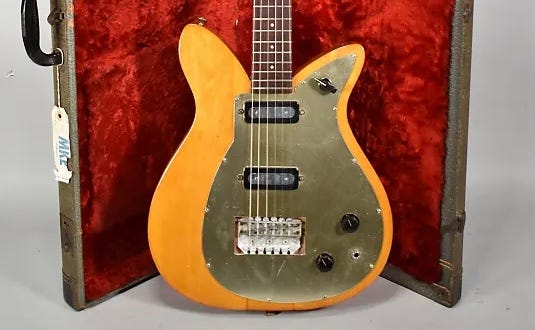
Apart from the extra pickup and the associated wiring, the 450’s features were mostly identical to the “donor” 400. How these guitars were assembled was unique. The one piece maple neck and alder body wings were shaped and finished separately, and then glued and stapled together before the hardware was added. The finish on these early guitars was nitrocellulose, so finish checking and even flaking is not uncommon today. Colors offered were Jet Black, Cloverfield Green, and Montezuma Brown.

The neck featured maple headstock wings, and a “rosewood” fingerboard with dot position markers. I have “rosewood” in quotes because I don’t know the exact timeline here—early Rickenbackers used Brazilian rosewood, and at some point moved to “African rosewood” or bubinga. Where that happened on the 450’s timeline I just don’t know. Tuners were open-backed Grover “Sta-Tites”.

While a handful of prototypes, like the refinished one above and the one shown in the 1957 catalog here wear two of the DeArmond pickups found on the Combo 400, “production” guitars featured the brand-new toaster pickups—although that name was years away from being adopted. Period literature simply referred to them as the “Rickenbacker Electric Pickup.”
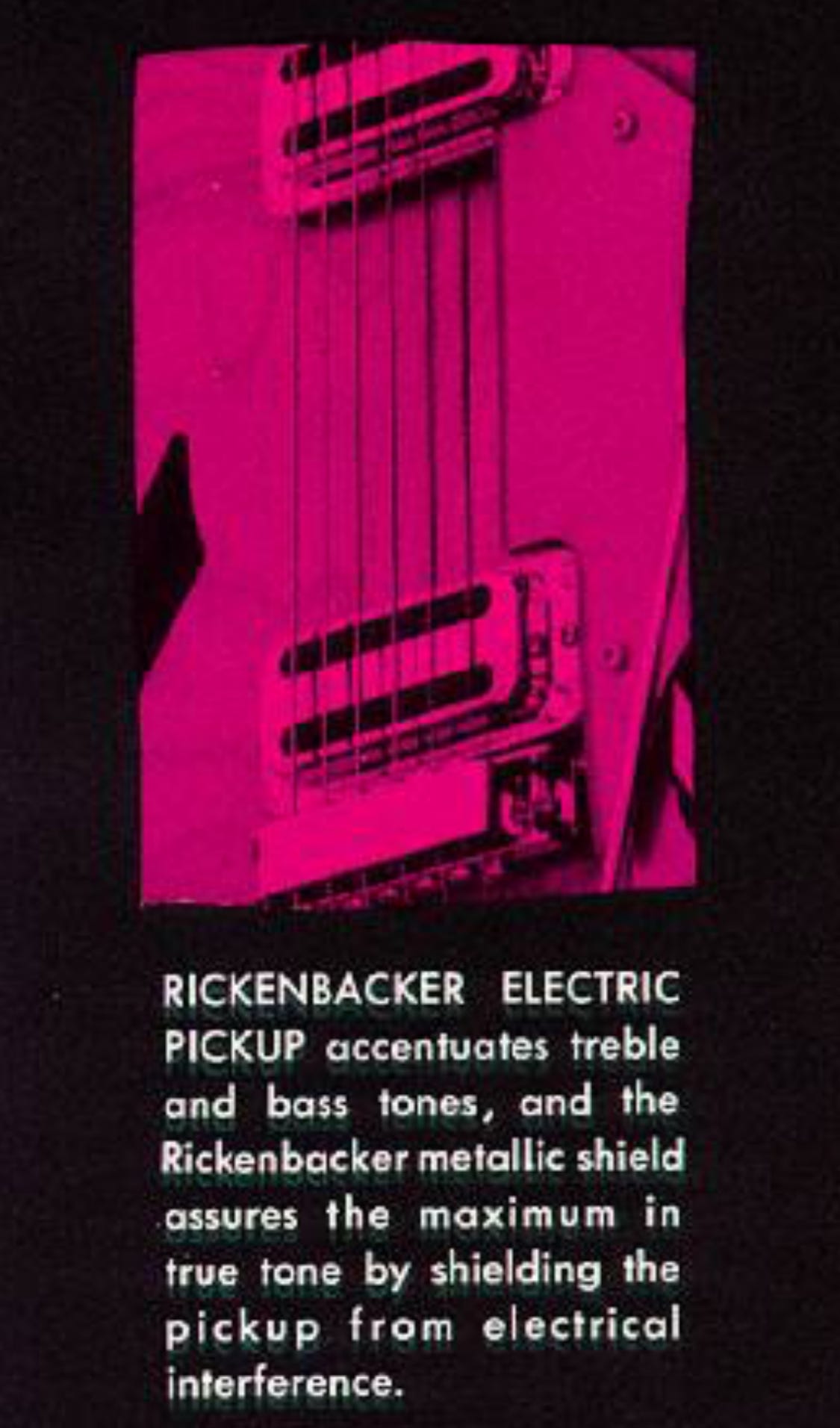
One other prototype feature that can be seen in both examples above that would not make it to production models was a rotary pickup selector switch. This would be replaced by a standard three way toggle switch. The 400’s toggle in the same location was a tone circuit control, much like on a contemporary Fender Esquire. Other controls were a master volume and master tone, with a face mounted output jack.

The large pickguard which covered most of the guitar’s face was gold-anodized aluminum, as was the truss rod cover. The same bridgeplate and six-saddle adjustable bridge as found on the Combo 600, 800, and 400 was used, covered by a removable gold-anodized “ashtray”.
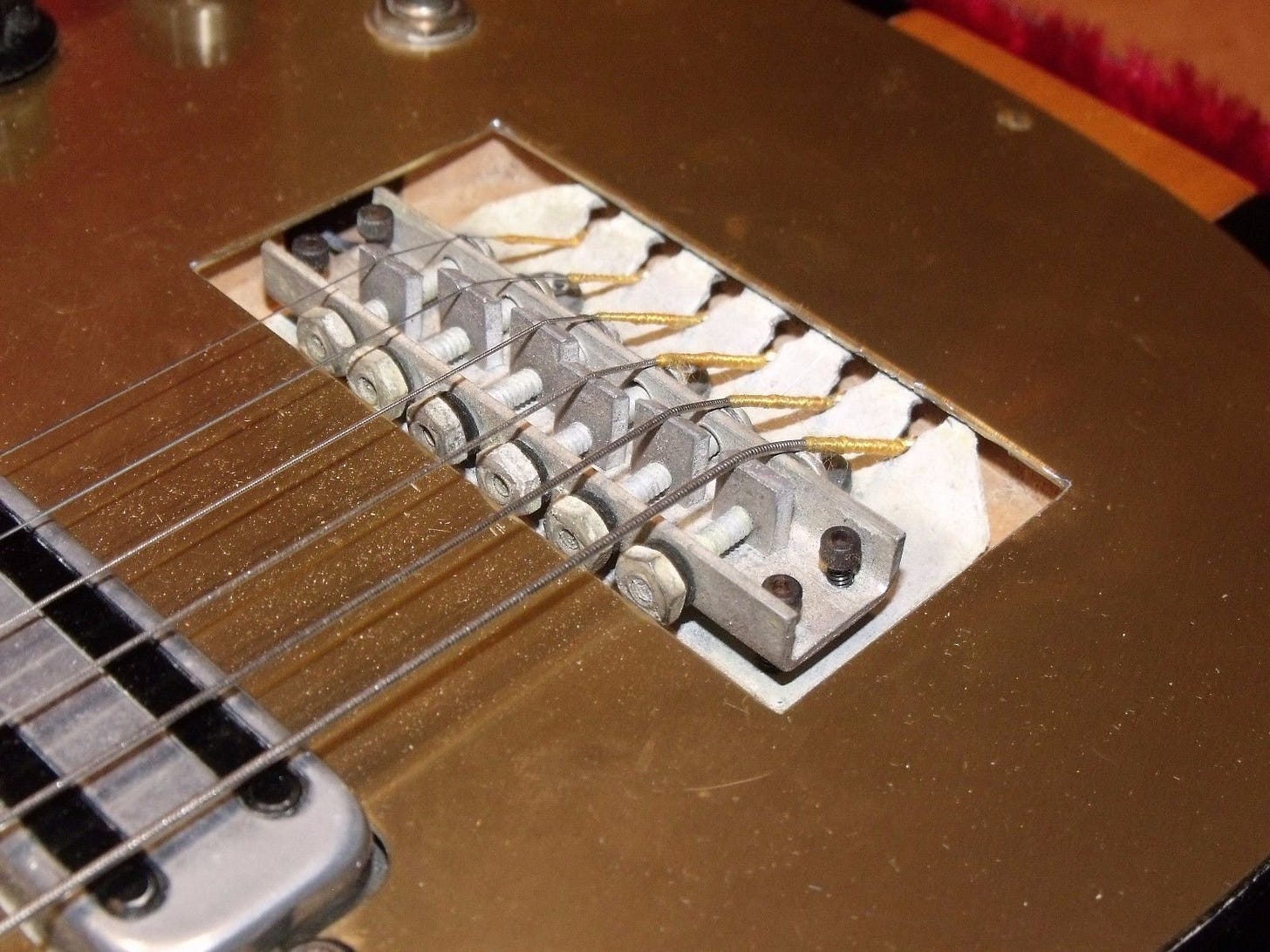
Like other Rickenbackers of this era, the Combo did not feature strap buttons. Instead, an inset hook on the back surrounded by a metal ring (which bore the stamped serial number) was provided for the use of a saxophone type hook strap to “enable the player to make quick changes from one instrument to another”—something even period players found inconvenient!


We should also mention that cover on the back. When the Combo 400 launched in 1956, it featured a grey “flocked” material applied to the back of the guitar. Its purpose? Unclear. The most logical answer is to provide some “grip” for the guitar’s back given the single-point-of-contact strap system. We’ll likely never know the full reasoning.
The 450, however (and the 900, 950, and 1000 that launched at the same time), had a white plastic backplate. Given that the smooth material fails to provide the same “grip” as the flock, its purpose is even less clear. But there it was.
And so the final specs for the 450 were set. Well, for a couple of months anyway! Because before the year even ended the first significant changes occurred.
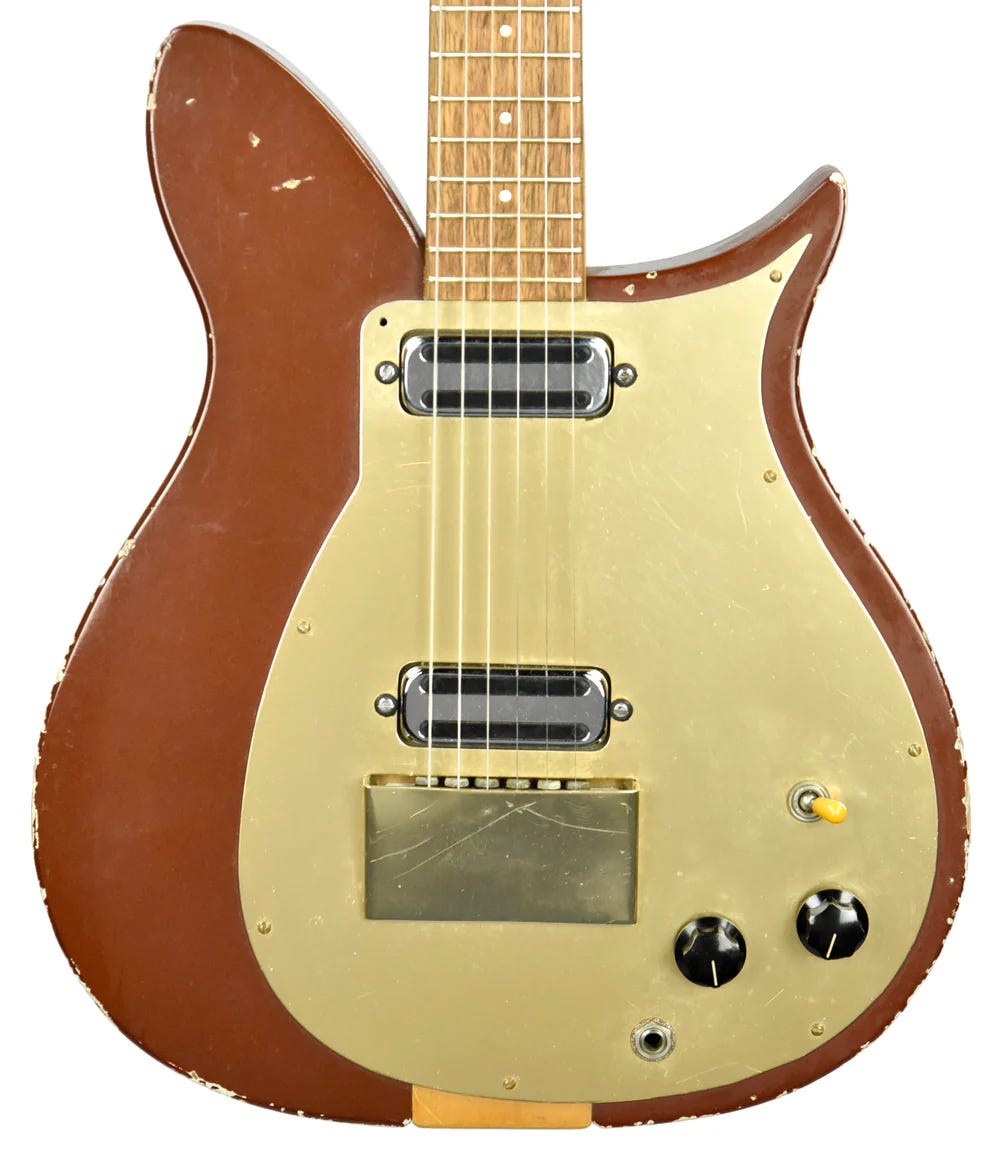
Realizing that access to the upper frets was limited by the convex cutaway on the treble side, Roger Rossmeisl trimmed it way back, creating the same basic cutaway shape that persists to this day on the 620 and 660. At the same time, the “bridge” pickup was moved much closer to the bridge, and the three way toggle switch moved down from the (now greatly reduced) upper bout to near the other controls.

1958
As it turned out, the “half-tulip” was only temporary. It didn’t take long for Rossmeisl to take a hacksaw to the other half of the tulip. In doing so—and inspired by the 4000’s design—he gave birth to the cresting wave body still in use over 65 years later.

Scroll back up through the photos and notice how the body outline remains unchanged throughout this process—only the “inside” of the cutaways change.

The first few 1958 cresting wave 450s would have a slightly different control layout than the ones that came before and would come after: the same two knob/two switch harness found on some of the early Capri models.
A number of changes would occur fairly rapidly—and in some cases simultaneously—in the back half of the year. The most significant would be a change in the construction itself: no longer would the wings and neck be built and finished separately. Instead, the front and back would be planed, sanded, and finished as one unit, removing the visible “channel” between the neck and wings. For some reason, the neck north of the heel did not get the same color coat as the rest of the guitar as standard. The staples would be removed as part of the construction process and only glue would hold things together. Jet Black would be the only color offered as standard on the cresting wave 450, although a handful of custom color guitars exist.

At the same time, controls would change to the now-standard two volume/two tone/3 way pickup selector switch. The headstock construction would change slightly, with the maple wings being replaced by walnut. And then there was the new truss rod cover.

Referred to today by collectors as the “aluminum foil” truss rod cover, this new uniquely shaped item was issued to all “student” and entry-level guitars: the 425, 450, 900, 950, and 1000. It was made of thin, stamped metal—obviously more durable than aluminum foil, but still very prone to denting—with a dark gray wash.
It’s hard to say exactly when strap buttons were added as pretty much every guitar has them today, but we can say that by the end of the year the saxophone ring—and the back plate!—were gone. The serial number moved to the bridge plate once the back ring was gone.

1959
After two years of near constant change, 1959 was relatively quiet. Fireglow and Natural (the “Fireglo” and “Mapleglo” names would not be adopted until 1967) were added to the color palette. Early in the year, single-line Kluson Deluxe tuners with nickel “bean” keys would replace the Grover Sta-Tites.
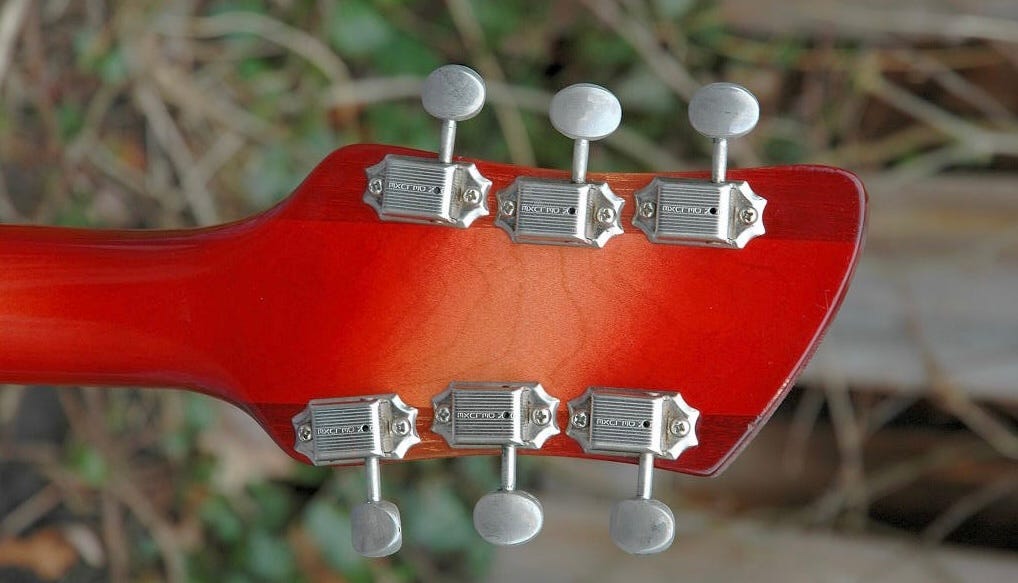
And—across the entire line—the nitrocellulose finish would be phased out and replaced with a conversion varnish.
1960

Around November/December, the “aluminum foil” truss rod cover was replaced by the gold backpainted plexiglass unit that was in use across the rest of the line.
1961
While changes had been relatively minor to the Combo 450 for the past two years, quite a lot changed in 1961. Including the name! The “Combo” designation was dropped, leaving it “just” the 450.
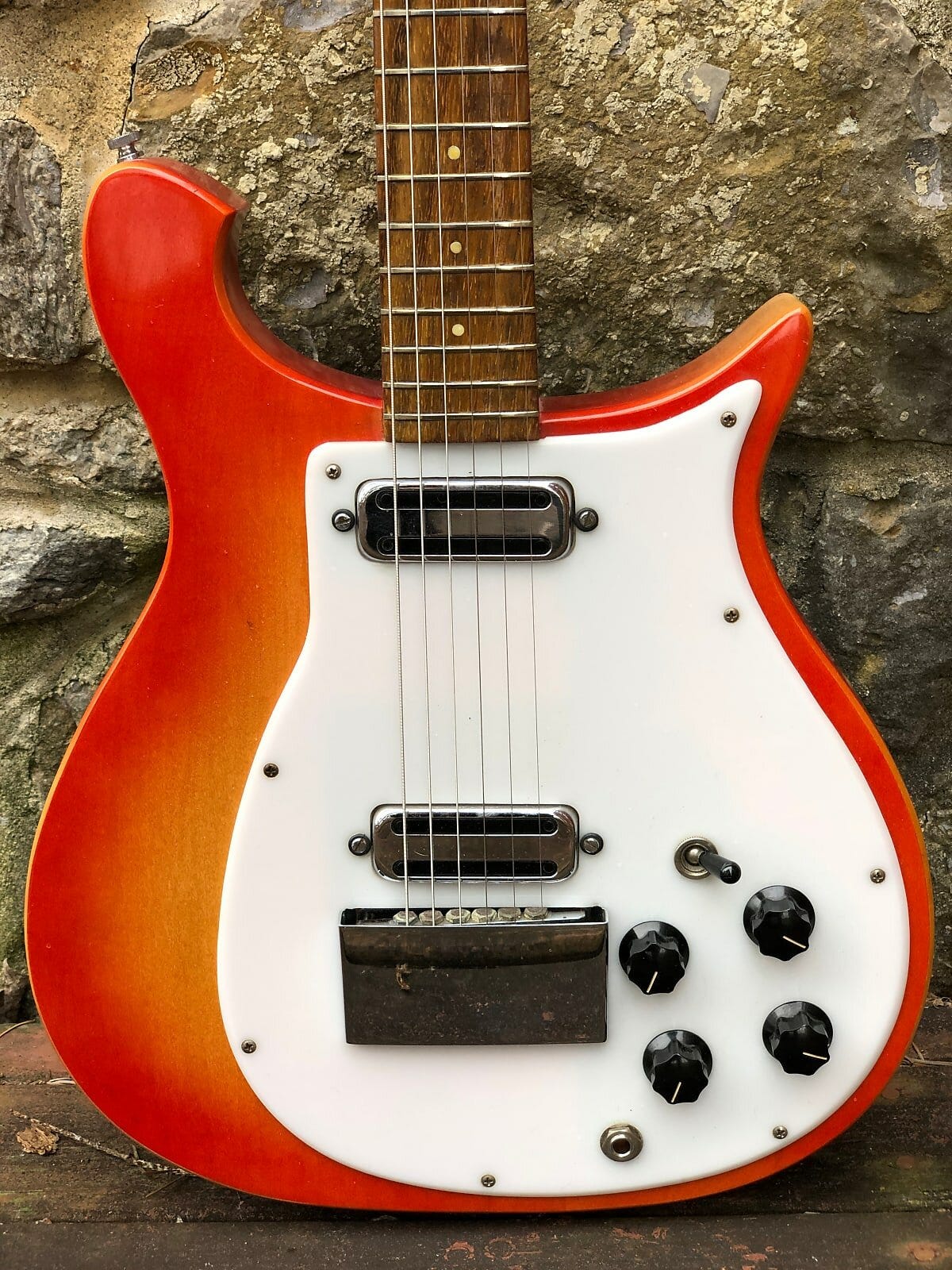
In February, the anodized pickguard was replaced with white plastic. The clip-in ashtray cover over the bridge remained, but changed from gold anodized to chrome.
The bigger change occurred mid-year: the “slab” body was slimmed down to 1 5/8”, and the edges were contoured in the “arm wear” areas to provide a more comfortable playing experience.
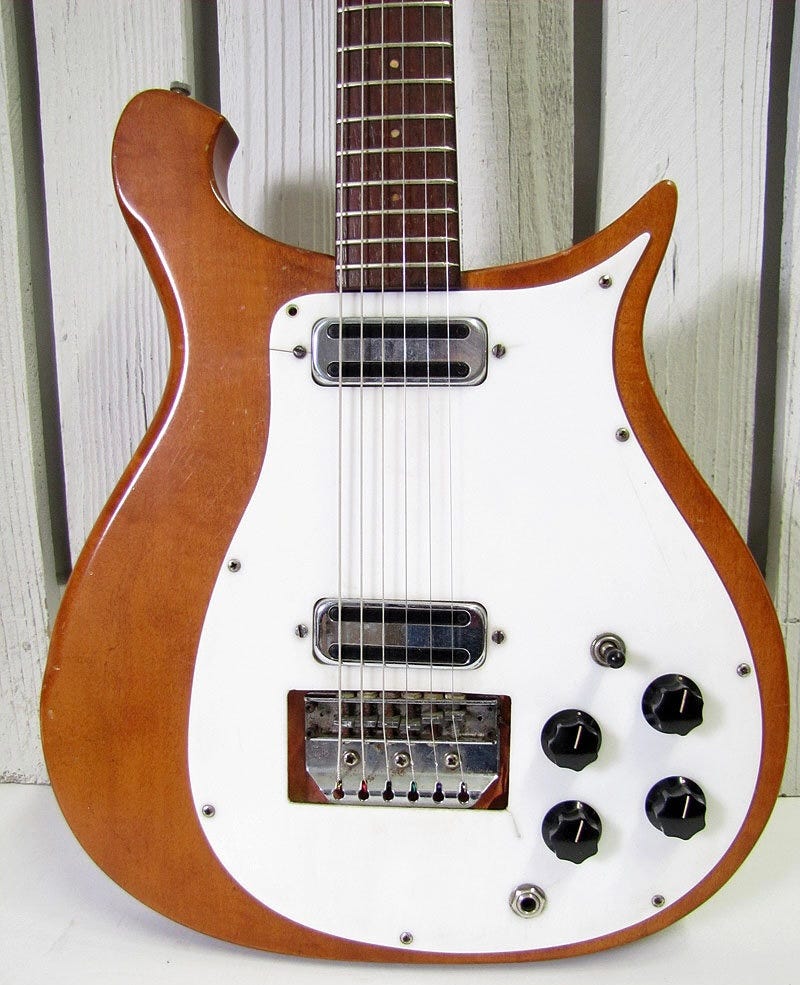
1963
The final “significant” change to the 450’s design would occur in 1963. The Rickenbacker standard 6-saddle adjustable bridge was replaced with a floating, compensated unit on a shorter bridgeplate.
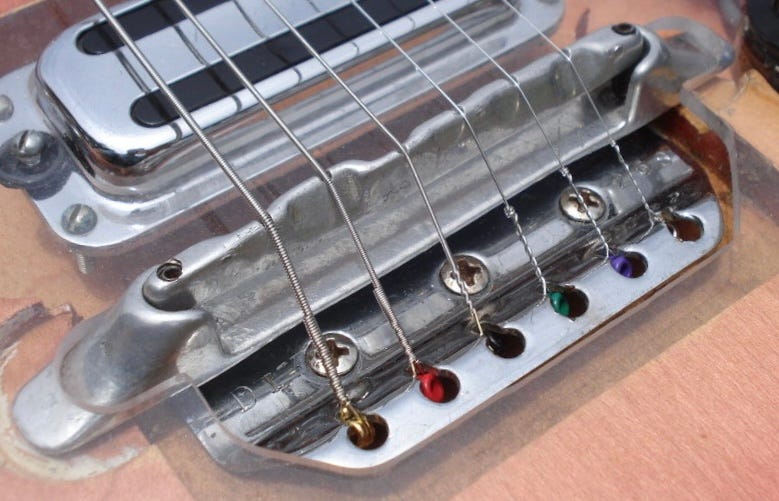
The bridge ashtray was discontinued, and pickguard was redesigned to more closely follow the bridge footprint.

The other changes came on the headstock: the headstock wings reverted to maple and the truss rod cover for all models transitioned to white backpainted plexiglass.

1964
The neck heel changed from square to rounded. From this point forward to its discontinuation in 1985 there would be no “model-specific” changes to the 6-string 450.
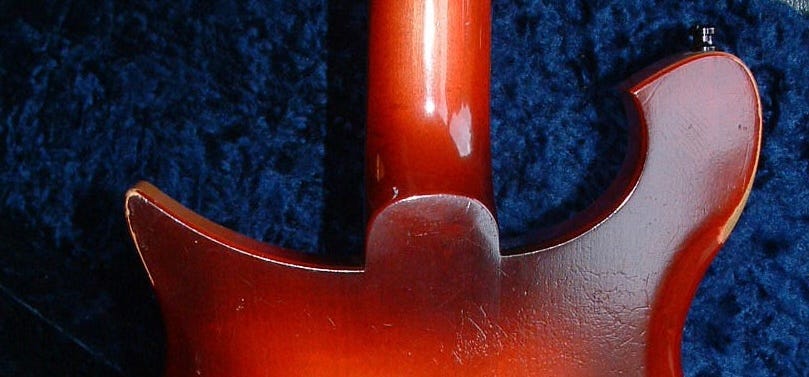
In 1964 Kluson changed the Deluxe tuner backs from “single line” to “double line”, with the change appearing throughout the Rickenbacker line early in the year.


At British distributor Rose Morris’s request, “MADE IN U.S.A.” was added to the backpainted plexi truss rod cover. It would be printed parallel and below “Rickenbacker” for all models, including the 450.
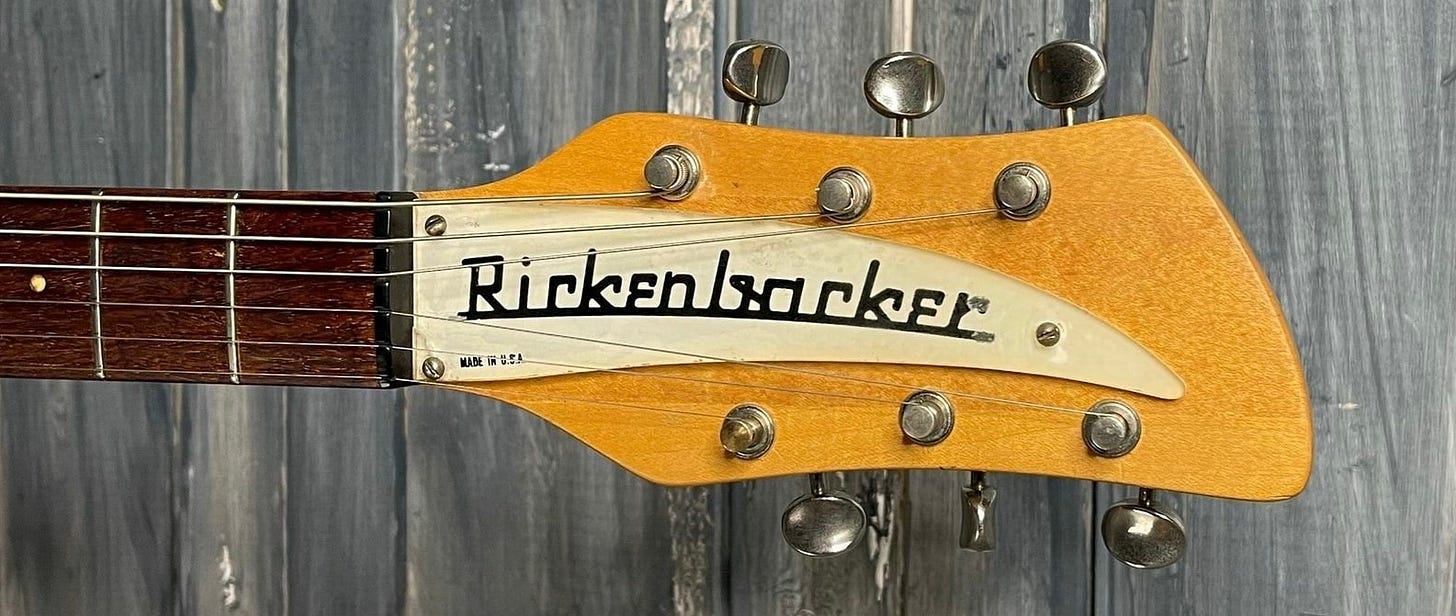
1965

While prototypes were built in late 1964, the 12-string 450/12 officially launched in 1965–the first production solidbody Rickenbacker 12 string guitar. Apart from the obvious headstock changes, the rest of the guitar was identical to the 6 string version.

Midway through the year the bridgeplate reverted to the older “long” version—likely in response to stringing difficulties caused by the short distance between the anchor holes and the compensated bridge. Around the same time, the previously raw cast compensated bridge gained chrome plating. As a result of the new bridgeplate footprint, the cutout on the pickguard was enlarged to accommodate. The change was applied to both 6 and 12 string guitars.


In mid June, the control knobs changed from the black “vintage” style knobs to the new silver top knobs. The first version had no labels and a dash indicator on the top.

In August the knobs would gain the now-familiar BASS/TREBLE TONE/VOLUME labels.

1966
Rickenbacker used the same base body and neck as the 450 on the one pickup 420/425 from its launch in 1958. When modified to be sold as the private label ES-17, construction changed to a two piece body with a set neck to reduce costs—although the two versions were used interchangeably during this period for both 425s and ES-17s.
For reasons unknown, between February and June of 1966 the majority—but not all—of the 450/12s produced utilized this set neck construction.
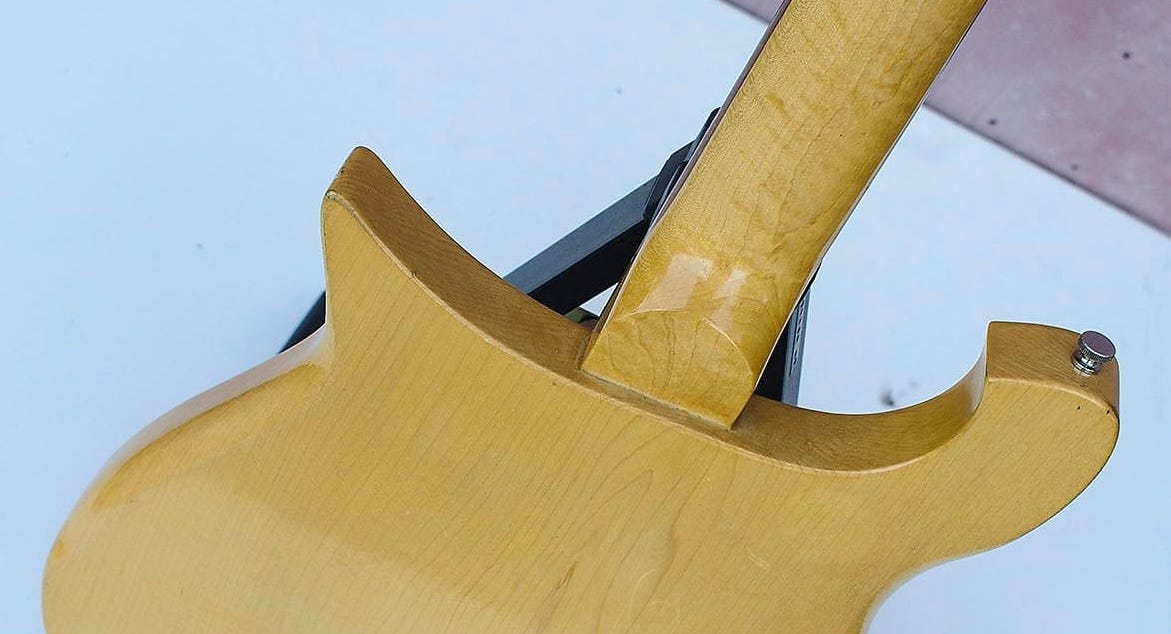
Around September the “final” version of the silver top knobs would appear, with dots replacing the dashes on the top—although you will find guitars into 1967 with the old dash tops and even mismatched knobs.

1967

The 6/12 string “converter” 456/12 was introduced, along with the similarly equipped 336/12 and 366/12. When engaged, the comb you see above captures and pulls down the octave strings, muting them and “converting” the 12 string guitar to 6 strings.

On the semi-hollowbodied 330 and 360 with their top-mounted pickups, the converter assembly had to be raised up from the guitar face to “reach” the strings. With the much lower deck height on the 450, the assembly actually had to be lowered to fit under the strings. As can be seen above, a section of the pickguard was removed to provide clearance. A very thin piece of black plastic sheeting was installed under the pickguards to fill the gap (and cover the routs!), held in place by the pickguard screws.
Much can be said about the converter guitars, but in the end it was a novel idea of limited utility that did not last long in the marketplace.
1968
Towards the end of the year the MADE IN THE U.S.A. imprint on the backpainted plexi truss rod cover would move from parallel to perpendicular to the Rickenbacker logo, by the nut. While number of guitars would also see their model number printed above the MADE IN U.S.A. marking, the 450 would not.
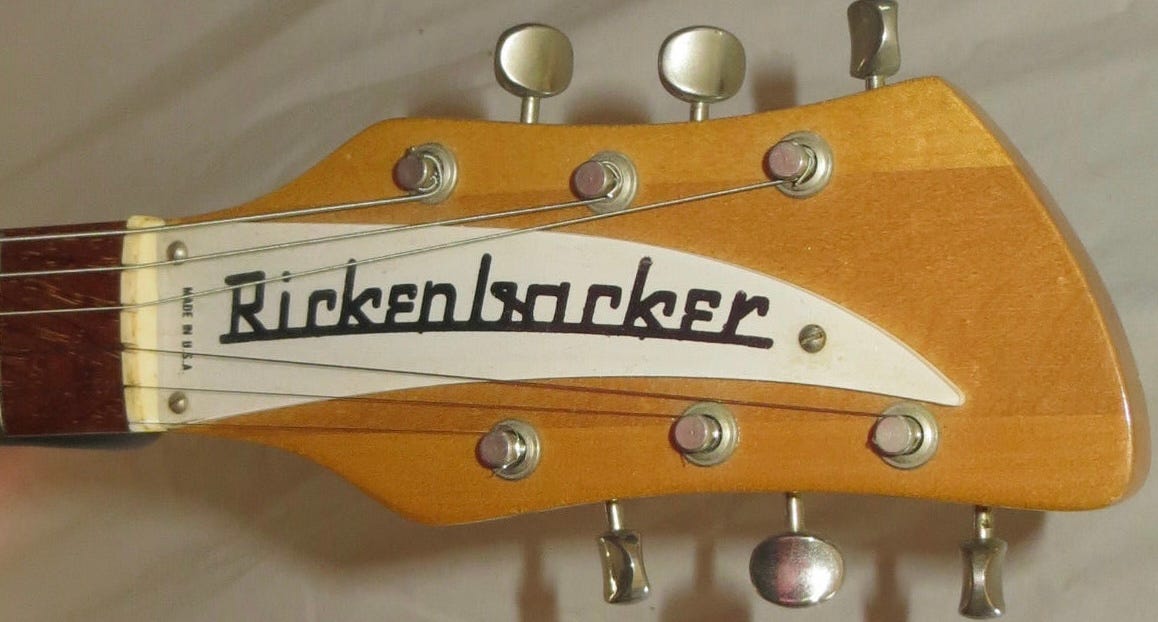
While it would remain on the price list through 1975, the last 456/12s were produced in September.
1974
In January the 425 and 450 would become the last two guitars to make the transition from toasters to button-top Higains.
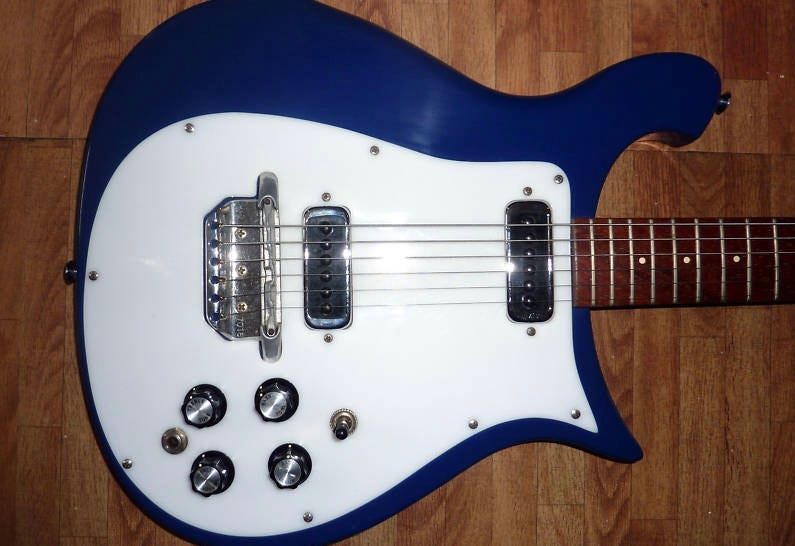
1975
In late 1975, the old style backpainted plexi truss rod cover was replaced on all models by an injection molded cover with a raised logo. The logo would be painted black, and MADE IN U.S.A. was stamped at the bottom by the nut. Higher volume guitars would also have their model number stamped below the MADE IN U.S.A., but the 450 did not.

1982-1984
In late 1981 Kluson went out of business. From early 1982 until the last production run in 1984, 450’s came equipped with a mixture of leftover Kluson Deluxe, Grover Slimline, or Grover Rotomatic tuners, depending on what was handy at the time.

1985
In 1985 the 450 and 450/12 were dropped from the price list, ending the run of the only guitar in the line that could directly trace its lineage all the way back to 1956–before any other modern Rickenbacker had even been dreamt of.
POST SCRIPT:
1999
The limited edition 425V63 and 450V63 reissue models were announced. Inspired by George Harrison’s 1963 425, they were fairly faithful reproductions of the 1963 originals. The two details they got “wrong” were the colors (offered in Jetglo—which was fine—and Burgundy, which was not available in 1963), and the bridgeplate—the “long” version was used but the “short” version would have been correct for 1963.
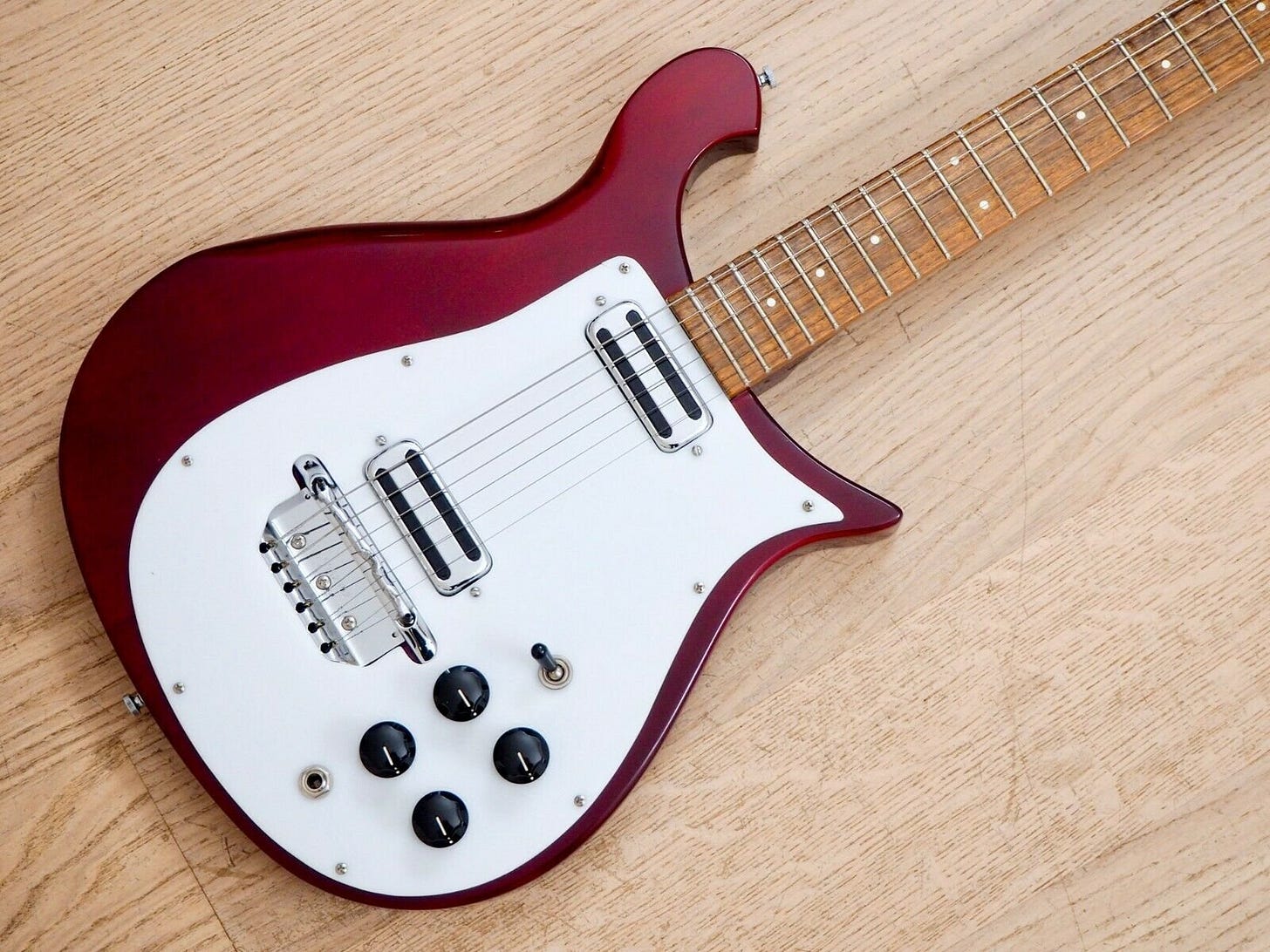
80 were produced in Burgundy and 61 in Jetglo. For a long time the 450V63 would have the distinction of being the only Rickenbacker reissue model that was worth more than the original it was emulating.
And that’s all there is know about the 450. It just so happens to be my favorite Rickenbacker—lightweight, low deck height, and solidbody sustain. If you haven’t tried one…what are you waiting for?

